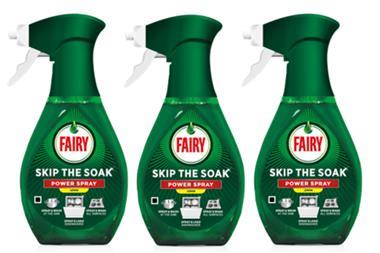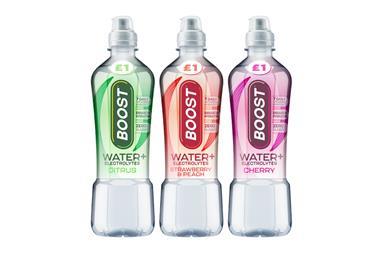Market conditions are ripe for cereal bars, but too many product launches could be confusing for consumers, says Ronan Hegarty
When is a cereal bar not a cereal bar? Well, that is a question which, according to major manufacturers, is getting consumers in a muddle and holding back a burgeoning category.
An ever-increasing demand for snacking on the go, combined with consumer desire for healthier options, has created the perfect market conditions for cereal bars to prosper. Indeed, the market is currently growing at 7.2% year on year and is worth £258m (IRI data, 52 weeks to May 20, 2006).
However, according to Ken Wood, chief executive of the Weetabix Food Company, the cereal bars sector is one of the most confusing in the grocery sector. He explains that this is due to the volume of launches by a range of manufacturers, from small and large cereal producers to makers of confectionery and biscuits.
This has led to a huge amount of choice for consumers, who can pick up anything from cereal bars made with flakes, muesli bars with a high fruit content, to baked bars and typical confectionery-style bars.
Wood says that for the success to continue, what's needed is "significant rationalisation of the fixture and greater clarity of the roles that the respective brands play. Focused innovation that adds value and seeks to bring new users into the category is essential for future market growth," he adds.
The large cereal producers control the lion's share of the market, with Kellogg's in particular to the fore. The cereal giant makes three of the UK's four top-selling cereal bars with its Nutrigrain, Special K and Cereal & Milk bars.
Kellogg's UK sales director Kevin Brownsey sees cereal bars as the ideal alternative to more traditional snacks such as crisps and chocolate bars, and is continuing to develop brand extensions of its best-selling cereal lines to satisfy this need.
"The consumption of high-carbohydrate snacks between meals has been shown to lower overall daily calorie intake and helps reduce hunger. Cereal bars are typically lower in fat, salt and sugar than more traditional snacks," Brownsey explains.
While cereal producers emphasise the healthy attributes of cereal bars, major confectionery producers have also made it into the cereal bar top 10 with their more indulgent products. Cadbury's Brunch is at number five while Masterfoods Tracker bar comes in at six.
Cadbury's Brunch is clearly targeted at consumers looking for a morning snack and has benefited from the perception that cereal bars represent 'good' food to enjoy on the go. Consumers are continuing to skip breakfast, according to Brownsey, but he and other suppliers are keen that cereal bars should break out of being regarded simply as a breakfast substitute and become viewed more as healthy alternatives to traditional snacks. This can lead to mixed messages, but most suppliers appear to be in agreement that health is the number one selling point for cereal bars.
Ryvita customer marketing manager Georgina Edmonds spells it out: "The current debate over healthy eating and obesity will certainly highlight to consumers that snacks such as crisps can be very unhealthy and will encourage consumers to look at nutritionals on pack.
"Consumer research has shown that cereal bars are already a multiple eating occasion. As Ryvita Goodness bars are an overall healthier snacking choice, we hope that they will continue to be increasingly chosen as a mid-morning snack or afternoon treat instead of a chocolate bar or bag
of crisps."
Producers are looking to hit home this advantage by continuing to deliver new and interesting flavours, as well as hitting on major food trends such as superfoods, prebiotics and the much-publicised omega 3.
Harriet Gregory, controller of new product development with cereal bar specialist Eat Natural, believes that the opportunities are endless when it comes to new flavours. "Things are very exciting at the moment. The demand for superfoods has led to some great new flavours. We are using blueberries and cranberries and also looking at interesting seasonal lines to take advantage of some great natural products," she says.
So what next for cereal bars? As well as replacing traditional snacks, will they also move into the functional foods category with the additions of omega 3? Kellogg's says it has no plans at the moment to add omega 3 to its cereal bars, but other manufacturers are more keen.
Gregory explains that many of the nuts that Eat Natural uses contain similar properties to omega 3 and omega 6 and it is these healthy properties which she says will help the market grow by 49% over the next five years.
Ryvita's Edmonds agrees: "Trends such as omega 3 are now appearing in cereals and these trends are likely to carry over into the cereal bar market, in a move similar to that of prebiotics."
Ryvita bars, which were launched at the beginning of this year, contain naturally occurring prebiotics as a result of using vegetable fibres, rather than glucose syrup, sugar or honey to hold the ingredients together.
The Weetabix Food Company is keen to push the health benefits of its latest launch, Alpen Light cereal bars, which contain added prebiotics. The bars, launched at the beginning of the year, are low in saturated fat, high in fibre and contain less than 70 calories. The company hopes they will appeal to young adults, with a female bias, who are constantly on the go.
Wood claims: "We are driving the category forward with the introduction of Alpen Light cereal bars because they provide a great healthier alternative to regular cereals."
cereal bars MARKET SHARES
1. Kellogg's Nutrigrain 10.0%
2. Kellogg's Special K 8.4%
3. Alpen Original 7.5%
4. Kellogg's Cereal & Milk Bars 6.2%
5. Cadbury's Brunch 5.4%
6. Mars Tracker 4.5%
7. Quaker Harvest Cheweee 4.3%
8. Kellogg's Nutrigrain Elevenses 4.2%
9. Eat Natural 3.9%
10. Jordan's Frusli 3.4%
Source: IRI data, 52 weeks ending May 20, 2006
When is a cereal bar not a cereal bar? Well, that is a question which, according to major manufacturers, is getting consumers in a muddle and holding back a burgeoning category.
An ever-increasing demand for snacking on the go, combined with consumer desire for healthier options, has created the perfect market conditions for cereal bars to prosper. Indeed, the market is currently growing at 7.2% year on year and is worth £258m (IRI data, 52 weeks to May 20, 2006).
However, according to Ken Wood, chief executive of the Weetabix Food Company, the cereal bars sector is one of the most confusing in the grocery sector. He explains that this is due to the volume of launches by a range of manufacturers, from small and large cereal producers to makers of confectionery and biscuits.
This has led to a huge amount of choice for consumers, who can pick up anything from cereal bars made with flakes, muesli bars with a high fruit content, to baked bars and typical confectionery-style bars.
Wood says that for the success to continue, what's needed is "significant rationalisation of the fixture and greater clarity of the roles that the respective brands play. Focused innovation that adds value and seeks to bring new users into the category is essential for future market growth," he adds.
The large cereal producers control the lion's share of the market, with Kellogg's in particular to the fore. The cereal giant makes three of the UK's four top-selling cereal bars with its Nutrigrain, Special K and Cereal & Milk bars.
Kellogg's UK sales director Kevin Brownsey sees cereal bars as the ideal alternative to more traditional snacks such as crisps and chocolate bars, and is continuing to develop brand extensions of its best-selling cereal lines to satisfy this need.
"The consumption of high-carbohydrate snacks between meals has been shown to lower overall daily calorie intake and helps reduce hunger. Cereal bars are typically lower in fat, salt and sugar than more traditional snacks," Brownsey explains.
While cereal producers emphasise the healthy attributes of cereal bars, major confectionery producers have also made it into the cereal bar top 10 with their more indulgent products. Cadbury's Brunch is at number five while Masterfoods Tracker bar comes in at six.
Cadbury's Brunch is clearly targeted at consumers looking for a morning snack and has benefited from the perception that cereal bars represent 'good' food to enjoy on the go. Consumers are continuing to skip breakfast, according to Brownsey, but he and other suppliers are keen that cereal bars should break out of being regarded simply as a breakfast substitute and become viewed more as healthy alternatives to traditional snacks. This can lead to mixed messages, but most suppliers appear to be in agreement that health is the number one selling point for cereal bars.
Ryvita customer marketing manager Georgina Edmonds spells it out: "The current debate over healthy eating and obesity will certainly highlight to consumers that snacks such as crisps can be very unhealthy and will encourage consumers to look at nutritionals on pack.
"Consumer research has shown that cereal bars are already a multiple eating occasion. As Ryvita Goodness bars are an overall healthier snacking choice, we hope that they will continue to be increasingly chosen as a mid-morning snack or afternoon treat instead of a chocolate bar or bag
of crisps."
Producers are looking to hit home this advantage by continuing to deliver new and interesting flavours, as well as hitting on major food trends such as superfoods, prebiotics and the much-publicised omega 3.
Harriet Gregory, controller of new product development with cereal bar specialist Eat Natural, believes that the opportunities are endless when it comes to new flavours. "Things are very exciting at the moment. The demand for superfoods has led to some great new flavours. We are using blueberries and cranberries and also looking at interesting seasonal lines to take advantage of some great natural products," she says.
So what next for cereal bars? As well as replacing traditional snacks, will they also move into the functional foods category with the additions of omega 3? Kellogg's says it has no plans at the moment to add omega 3 to its cereal bars, but other manufacturers are more keen.
Gregory explains that many of the nuts that Eat Natural uses contain similar properties to omega 3 and omega 6 and it is these healthy properties which she says will help the market grow by 49% over the next five years.
Ryvita's Edmonds agrees: "Trends such as omega 3 are now appearing in cereals and these trends are likely to carry over into the cereal bar market, in a move similar to that of prebiotics."
Ryvita bars, which were launched at the beginning of this year, contain naturally occurring prebiotics as a result of using vegetable fibres, rather than glucose syrup, sugar or honey to hold the ingredients together.
The Weetabix Food Company is keen to push the health benefits of its latest launch, Alpen Light cereal bars, which contain added prebiotics. The bars, launched at the beginning of the year, are low in saturated fat, high in fibre and contain less than 70 calories. The company hopes they will appeal to young adults, with a female bias, who are constantly on the go.
Wood claims: "We are driving the category forward with the introduction of Alpen Light cereal bars because they provide a great healthier alternative to regular cereals."
Top 10 cereal bars
cereal bars MARKET SHARES
1. Kellogg's Nutrigrain 10.0%
2. Kellogg's Special K 8.4%
3. Alpen Original 7.5%
4. Kellogg's Cereal & Milk Bars 6.2%
5. Cadbury's Brunch 5.4%
6. Mars Tracker 4.5%
7. Quaker Harvest Cheweee 4.3%
8. Kellogg's Nutrigrain Elevenses 4.2%
9. Eat Natural 3.9%
10. Jordan's Frusli 3.4%
Source: IRI data, 52 weeks ending May 20, 2006































No comments yet